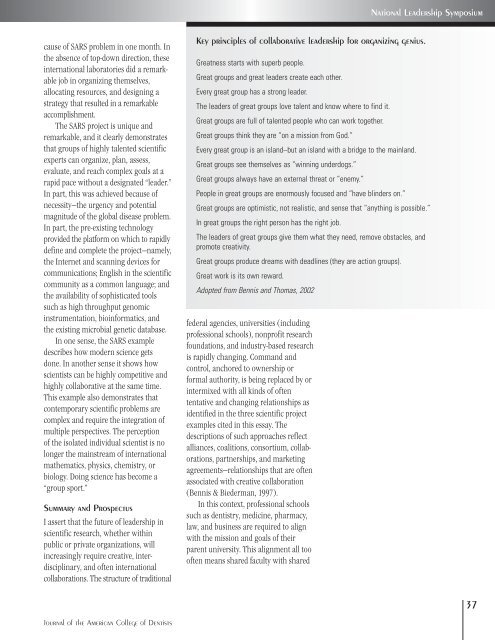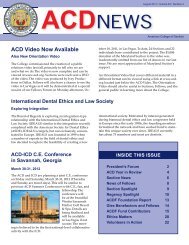JACD 71-4 - American College of Dentists
JACD 71-4 - American College of Dentists
JACD 71-4 - American College of Dentists
- No tags were found...
Create successful ePaper yourself
Turn your PDF publications into a flip-book with our unique Google optimized e-Paper software.
cause <strong>of</strong> SARS problem in one month. In<br />
the absence <strong>of</strong> top-down direction, these<br />
international laboratories did a remarkable<br />
job in organizing themselves,<br />
allocating resources, and designing a<br />
strategy that resulted in a remarkable<br />
accomplishment.<br />
The SARS project is unique and<br />
remarkable, and it clearly demonstrates<br />
that groups <strong>of</strong> highly talented scientific<br />
experts can organize, plan, assess,<br />
evaluate, and reach complex goals at a<br />
rapid pace without a designated “leader.”<br />
In part, this was achieved because <strong>of</strong><br />
necessity—the urgency and potential<br />
magnitude <strong>of</strong> the global disease problem.<br />
In part, the pre-existing technology<br />
provided the platform on which to rapidly<br />
define and complete the project—namely,<br />
the Internet and scanning devices for<br />
communications; English in the scientific<br />
community as a common language; and<br />
the availability <strong>of</strong> sophisticated tools<br />
such as high throughput genomic<br />
instrumentation, bioinformatics, and<br />
the existing microbial genetic database.<br />
In one sense, the SARS example<br />
describes how modern science gets<br />
done. In another sense it shows how<br />
scientists can be highly competitive and<br />
highly collaborative at the same time.<br />
This example also demonstrates that<br />
contemporary scientific problems are<br />
complex and require the integration <strong>of</strong><br />
multiple perspectives. The perception<br />
<strong>of</strong> the isolated individual scientist is no<br />
longer the mainstream <strong>of</strong> international<br />
mathematics, physics, chemistry, or<br />
biology. Doing science has become a<br />
“group sport.”<br />
Summary and Prospectus<br />
I assert that the future <strong>of</strong> leadership in<br />
scientific research, whether within<br />
public or private organizations, will<br />
increasingly require creative, interdisciplinary,<br />
and <strong>of</strong>ten international<br />
collaborations. The structure <strong>of</strong> traditional<br />
Journal <strong>of</strong> the <strong>American</strong> <strong>College</strong> <strong>of</strong> <strong>Dentists</strong><br />
Key principles <strong>of</strong> collaborative leadership for organizing genius.<br />
federal agencies, universities (including<br />
pr<strong>of</strong>essional schools), nonpr<strong>of</strong>it research<br />
foundations, and industry-based research<br />
is rapidly changing. Command and<br />
control, anchored to ownership or<br />
formal authority, is being replaced by or<br />
intermixed with all kinds <strong>of</strong> <strong>of</strong>ten<br />
tentative and changing relationships as<br />
identified in the three scientific project<br />
examples cited in this essay. The<br />
descriptions <strong>of</strong> such approaches reflect<br />
alliances, coalitions, consortium, collaborations,<br />
partnerships, and marketing<br />
agreements—relationships that are <strong>of</strong>ten<br />
associated with creative collaboration<br />
(Bennis & Biederman, 1997).<br />
In this context, pr<strong>of</strong>essional schools<br />
such as dentistry, medicine, pharmacy,<br />
law, and business are required to align<br />
with the mission and goals <strong>of</strong> their<br />
parent university. This alignment all too<br />
<strong>of</strong>ten means shared faculty with shared<br />
National Leadership Symposium<br />
Greatness starts with superb people.<br />
Great groups and great leaders create each other.<br />
Every great group has a strong leader.<br />
The leaders <strong>of</strong> great groups love talent and know where to find it.<br />
Great groups are full <strong>of</strong> talented people who can work together.<br />
Great groups think they are “on a mission from God.”<br />
Every great group is an island–but an island with a bridge to the mainland.<br />
Great groups see themselves as “winning underdogs.”<br />
Great groups always have an external threat or “enemy.”<br />
People in great groups are enormously focused and “have blinders on.”<br />
Great groups are optimistic, not realistic, and sense that “anything is possible.”<br />
In great groups the right person has the right job.<br />
The leaders <strong>of</strong> great groups give them what they need, remove obstacles, and<br />
promote creativity.<br />
Great groups produce dreams with deadlines (they are action groups).<br />
Great work is its own reward.<br />
Adopted from Bennis and Thomas, 2002<br />
37





